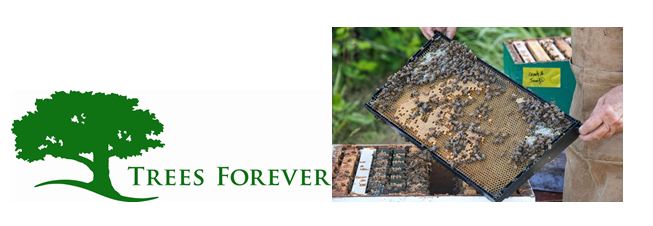MARION, IOWA-The natural habitat for butterflies, birds, bees and other pollinators is slowly being replaced by turf lawns and ornamental plants, but Trees Forever is helping landowners take active steps to save vital pollinators. Trees Forever is taking applications for 2020 Pollinator Habitat Conservation participants until September 30. This cost share/grant program works with farmers, landowners and communities to improve or create pollinator habitat. “Pollinators are directly responsible for about every third bite of food we consume,” Trees Forever Program Manager Debbie Fluegel said.
“The landowners participating in Trees Forever’s Pollinator Habitat program are playing an important role in recreating natural habitats by planting native plants, flowering shrubs and flowering trees.” The selected participants will be reimbursed up to $1,000 for 50% of their expenses to install or improve pollinator habitat. Some of these participating sites will also be showcased during a field day to educate the public about site preparation, appropriate plant species composition, and on-going maintenance requirements for the establishment of sustainable pollinator-friendly habitat. For more information and to apply for the Trees Forever’s Pollinator Habitat Conservation program, visit http://www.treesforever.org/PollinatorHabitatCons or contact Debbie Fluegel via email, dfluegel@treesforever.org or by phone, 309-613-0095.
______________________________________________________________________________________________________________________________________
Honey and Wild Salmon Used to Trace Lead in the Environment
Scientists have been able to trace sources of lead (and other metals) by analyzing the presence of lead isotopes in honey and Pacific salmon.
Scientists have combined analyses from honey and salmon to show how lead from natural and industrial sources gets distributed throughout the environment.
By analyzing the presence of lead isotopes in honey and Pacific salmon, Vancouver-based scientists have been able to trace the sources of lead (and other metals) throughout the region.
“We’ve found that we can let the bees do the hard the work for us…” Researcher, Kate Smith, sampling honey (credit: Dominique Weis).
“We’ve found that we can let the bees do the hard the work for us: they go to thousands of sites where metal-containing dust particulates might land, then bring samples back to a central hive. From there we can take the honey to have it analyzed and begin to identify the source of pollutants like lead,” said PhD candidate Kate Smith, part of a team working at the Pacific Centre for Isotopic and Geochemical Research, University of British Columbia.
In the webinar, Professor Chris Elliott examines the many different ways that meat fraud can manifest itself. From a dodgy butcher adding sawdust to his sausage to a national scandal involving large parts of the meat industry and government involved in corruption, bribery and cheating.
Once they have sampled the honey gathered by the bees, it is taken to a specialized geochemistry lab to be analyzed. This allows scientists to distinguish between different types (isotopes) of certain metal pollutants, like lead.
“Looking at the lead isotopic composition of the honey samples, we can tell the difference between honey gathered in the city centre of Vancouver and honey gathered in rural areas,” Smith continued. “We see that the trace amounts of lead in urban honey samples contain higher 208Pb/206Pb ratios that have no local natural equivalent, indicating that they come from man-made sources like aging city infrastructure and fuel combustion (e.g. cars and ships).
“Lead ratios measured in rural honey, on the other hand, reflect those of natural sources, like the local geology or particulates from nearby forest fires.”
“This work with honeybees is mirrored in initial findings from shellfish and salmon, ” added Dr Miling Li, postdoctoral researcher. “Juvenile salmon breed and live in remote freshwater ecosystems in British Columbia, and their lead composition reflects that found in nature, e.g. the nearby Garibaldi volcano range. Adult salmon that forage in the open ocean off the BC coast reveal isotopic compositions consistent with downtown Vancouver honeys.
This indicates that Pacific salmons were exposed to lead during their sea life mostly from anthropogenic sources in the Northeast Pacific Ocean.”
Although the sources of lead can be identified, the lead concentrations in both the honey and salmon from Vancouver and the surrounding areas are low and well below the reported world-wide average of lead in honey.
The UBC team has now developed standardized protocols for measuring lead isotopes in honey to apply the technique to other cities.
______________________________________________________________________________________________________________________________________
P.S. Have you seen our newest column in Bee Culture? It’s called ALL AROUND THE BEEYARD. Simply put, it’s a page of good ideas sent in by readers to make life in bees faster, simpler, easier, cheaper and better. Good ideas home grown and shared by those who saw a good idea. If you have a good idea you’d like to share, give us a paragraph or two on what it is, and a drawing or photo of what it looks like if that is needed to better share the idea. Send it in an email to Jerry@beeculture.com, with All Around in the subject line. Best of the month wins $100.00. The others get a free 1 year subscription. How cool is that?









